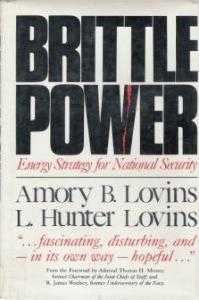Brittle Power
 | |
| Author |
Amory B. Lovins L. Hunter Lovins |
|---|---|
| Country | United States |
| Language | English |
| Subject | U.S. energy infrastructure |
| Publisher | Brick House Publishing Company |
Publication date | June 1982 |
| Pages | 486 |
| ISBN | 0-931790-28-X |
Brittle Power: Energy Strategy for National Security is a 1982 book by Amory B. Lovins and L. Hunter Lovins, prepared originally as a Pentagon study and re-released in 2001 following the September 11 attacks. The book argues that U.S. domestic energy infrastructure is very vulnerable to disruption, by accident or malice, often even more so than imported oil. According to the authors, a resilient energy system is feasible, costs less, works better, is favoured in the market, but is rejected by U.S. policy.[1] In the preface to the 2001 edition, Lovins explains that these themes are still very current.[2]
Vulnerability to large-scale failures
Lovins argues that the United States has for decades been running on energy that is "brittle" (easily shattered by accident or malice) and that this poses a grave and growing threat to national security, life, and liberty.[3]
Lovins explains that this danger comes not from hostile ideology but from misapplied technology. The size, complexity, pattern, and control structure of the electrical power system make it inherently vulnerable to large-scale failures. The same is true of the technologies that deliver coal, gas, and oil for running buildings, vehicles, and industries. Reliance on these delicately poised energy systems has unwittingly put at risk the entire American way of life.[3]
Lovins' detailed research shows that these vulnerabilities are increasingly being exploited. Brittle Power documents many significant assaults on energy facilities, other than during a war, in 40 countries and within the United States, in some 24 states.[4]
Resilient energy systems
Lovins explains that most energy utilities and governments are unsuccessfully trying to build high technical reliability into power plants so large that their cost of failure is unacceptable. A resilient energy supply system, on the other hand, consists of numerous, relatively small, each with a low individual cost of failure. A key feature which helps to make these energy sources resilient is that "they are renewable: they harness the energy of sun, wind, water, or farm and forestry wastes, rather than that of depletable fuels".[5]
Central message
Amory B. and L. Hunter Lovins reiterated the main message of Brittle Power in "Terrorism and Brittle Technology", Chapter 3 in Albert H. Teich's book Technology and the Future (2003):
The foundation of a secure energy system is to need less energy in the first place, then to get it from sources that are inherently invulnerable because they're diverse, dispersed, renewable, and mainly local. They're secure not because they're American but because of their design. Any highly centralised energy system -- pipelines, nuclear plants, refineries -- invite devastating attack. But invulnerable alternatives don't, and can't, fail on a large scale.[6]
Networked island-able microgrids
In his book Reinventing Fire (2011) Amory B. Lovins puts forward a vision of networked island-able microgrids where energy is generated locally from solar power, wind power, and other resources, and used by super-efficient buildings. When each building, or neighborhood, is generating its own power, with links to other “islands” of power, the security of the entire network is greatly enhanced.[7] Lovins has said that in the face of hundreds of blackouts in 2005, Cuba reorganized its electricity transmission system into networked microgrids and cut the occurrence of blackouts to zero within two years, limiting damage even after two hurricanes.[7]
See also
Major blackouts
- 2011 Southwest blackout
- March 2010 Chile blackout
- New York City blackout of 1977
- Northeast Blackout of 2003
Related publications
- Megaprojects and Risk: An Anatomy of Ambition (2003)
- Small Is Beautiful: A Study of Economics As If People Mattered (1973)
- Small is Profitable: The Hidden Economic Benefits of Making Electrical Resources the Right Size (2002)
- When Technology Fails (1994)
- Winning the Oil Endgame: Innovation for Profits, Jobs and Security (2005)
Related concepts
Further reading
Brittle Power is 500 pages long and has 1,200 references. It has been summarised and referred to in several other publications:
- "The Fragility of Domestic Energy". The Atlantic Monthly. 1983. Lay summary.
- "America's Energy Jugular" (PDF). Nuclear Arms: Ethics Strategy, Politics. 1984. Book chapter written for security professionals.
- Brief for a group of energy-industry leaders. Montreux Energy Roundtable. October 2001.
References
- ↑ Lovins, Amory B. (October 8, 2001). Critical Issues In Domestic Energy Vulnerability (PDF). Rocky Mountain Institute. Retrieved March 2, 2005.
- ↑ Lovins, Amory B. (October 21, 2001). "Preface". Brittle Power: Energy Strategy for National Security.
- ↑ 3.0 3.1 Lovins, Amory B. (October 21, 2001). Brittle Power: Energy Strategy for National Security (PDF). p. Chapter 1, p. 1.
- ↑ Brittle Power (PDF). p. Chapter 1, p. 2.
- ↑ Brittle Power (PDF). p. Chapter 16, pp. 264–266.
- ↑ Lovins, Amory B. Lovins & Lovins, L. Hunter Lovins (2003). "Terrorism and Brittle Technology". Technology and the Future (by Albert H. Teich) (Ninth ed.) (Thomson). p. 169.
- ↑ 7.0 7.1 Aston, Adam (March 16, 2012). "Amory Lovins on 'Reinventing Fire' with convergence and innovation". Greenbiz.
External links
- Lovins, Amory B. & Lovins, L. Hunter (Autumn 1983). "Real Security: Exposing vulnerabilities in our energy system so that we might overcome them". The Foundations Of Peace (Context Institute). p. 13. Document ID: IC#4.
- Lovins, Amory (2003). "Towering Design Flaws". Globe and Mail. Document ID: E03-06.
| ||||||||||||||||||||